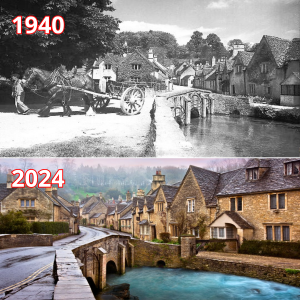
Nestled in the heart of the Cotswolds, the picturesque village of Castle Combe has long been a symbol of timeless English charm. Known for its quaint stone cottages, cobbled streets, and serene countryside, this village has preserved its character across the centuries, even as the world around it has changed. Comparing Castle Combe in the 1940s to its present-day appearance offers a unique glimpse into the enduring beauty of this historic location.
A Glimpse into the 1940s
During the 1940s, life in Castle Combe was simpler, yet steeped in the traditions that had defined the village for generations. A local man and his horse walking through the village, captured in a photograph from that era, embodies the rural lifestyle that dominated this part of England. The horse, a vital companion for transportation and farming, was an everyday sight, blending seamlessly with the village’s rustic surroundings. The cottages, built from local stone, with their thatched or tiled roofs, stood as they had for centuries, their appearance virtually unchanged since they were first constructed.
Castle Combe Today: A Living Legacy
Fast forward to today, and Castle Combe remains one of the most beautiful villages in England, often cited as a living postcard. The modern-day view retains much of the same charm seen in the 1940s, but with a few subtle changes that reflect the passage of time. The village has become a popular tourist destination, attracting visitors from around the world who are eager to experience its idyllic atmosphere.
While the horse has been replaced by cars and the occasional tourist bus, the essence of the village remains intact. The stone cottages still stand, their walls now weathered by an additional 80 years, and the streets still echo with the footfalls of those exploring this piece of history. The village’s appearance is largely protected by conservation efforts, ensuring that future generations will be able to enjoy the same views that their ancestors did.
Preserving the Past
The enduring appeal of Castle Combe lies in its ability to balance preservation with the inevitable march of progress. Efforts to maintain the village’s historical integrity have been largely successful, allowing it to serve as a bridge between past and present. This preservation is not just about maintaining buildings but also about keeping alive the stories and traditions that have been passed down through the centuries.
Conclusion
Castle Combe is more than just a beautiful village; it is a testament to the enduring nature of English rural life. Comparing photographs from the 1940s with those taken today shows how little has changed in this Cotswolds gem. The village continues to captivate all who visit, offering a window into a world that, despite the changes of modern life, remains remarkably and beautifully preserved.





